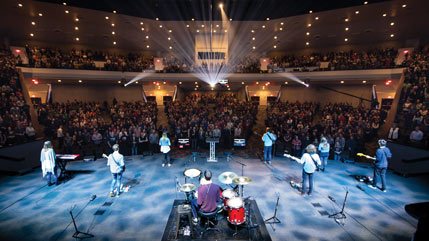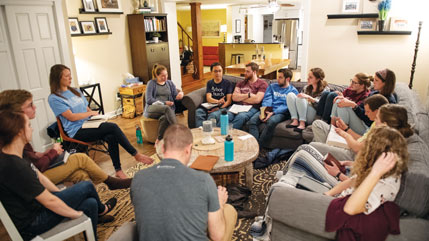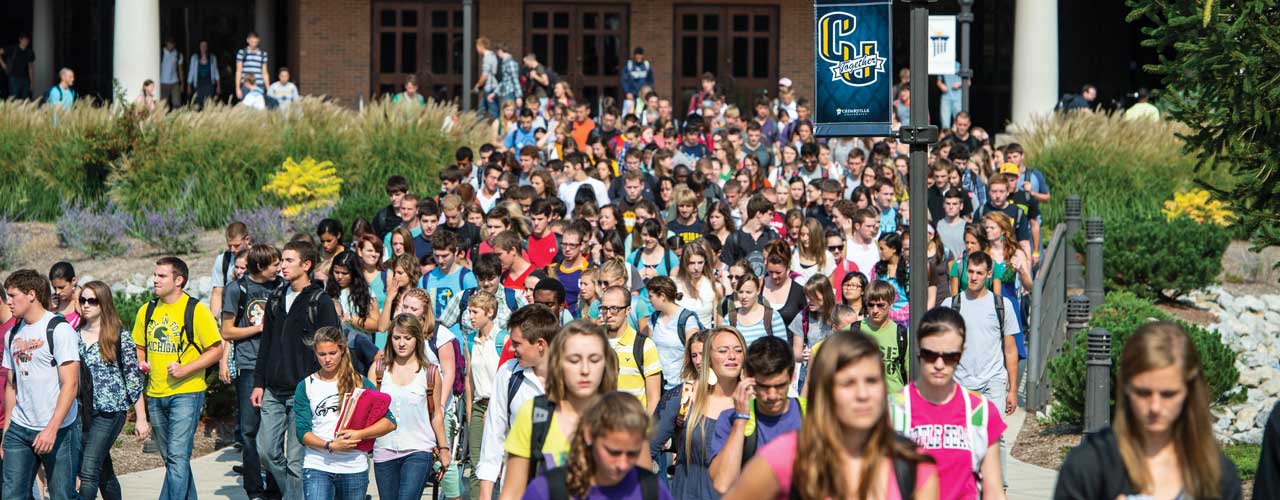by Jon Wood
The clock strikes 9:40 a.m., and all across campus professors begin wrapping up their lectures, introducing final points and preparing to transition students toward one of the most important experiences in their 1,000 days on campus.
As students file out of classes and pour onto sidewalks, the pulse of campus starts to beat a little faster. Once inside Jeremiah Chapel, between 9:50 and 10 a.m., the energy level rises by the minute as students find their seats. The buzz of conversation is fueled by the joy of friends connecting with each other yet again. The clock strikes 10, the lights transition, and chapel is on.
For anyone who has joined us for chapel, in person or online (and we do encourage you to do both as much as you can), you know that we offer faculty, staff, and students a steady nourishment of theologically rich musical worship, expositional preaching from God’s Word, and testimonies of faithful living. Throughout this 45 minutes, the focal point is understanding and living out the Word of God. While there is much I love about the biblical and theological heartbeat of our chapel programming, there is one other vitally important outcome: the community nurtured through daily chapel.
You see, the many fruits of chapel last far beyond the moment a final prayer is offered, and the students flow out of the auditorium to pursue the remainder of their day. Shortly after chapel, the clock strikes 11. Some will linger in the auditorium, visiting with friends, while others talk with faculty and staff and benefit from life-on-life discipleship moments. Yet, most will be off to class, lunch, or some other pursuit. In this daily rhythm, something remarkable happens: Community is cultivated through gathering and scattering.
GATHERING
How does daily chapel form community on campus? Simply, the act of gathering portrays the reality of community we share in Christ. While it may seem obvious, one cannot overlook the basic nature of community and the treasure of gathering together with other believers. Perhaps those of us who gather in settings of religious liberty can too easily forget the simple benefit of gathering.
Speaking into a cultural context where opposition to the Church was expected, the author of Hebrews recognizes the correlation between individual perseverance and corporate gathering when he calls his readers to “take care, brothers, lest there be in any of you an evil, unbelieving heart, leading you to fall away from the living God. But exhort one another every day, as long as it is called ‘today,’ that none of you may be hardened by the deceitfulness of sin” (Heb. 3:12–13, ESV; for further reading on this subject, see Hebrews 10:25).
 Required to meet underground amidst persecution in the
corroded atmosphere of the Third Reich, Dietrich Bonhoeffer’s
approach to Christian community emphasized the privilege
of gathering. “It is not simply to be taken for granted that the
Christian has the privilege of living among other Christians . . .The physical presence of other Christians is a source of
incomparable joy and strength to the believer,” he wrote in his
book, Life Together.
Required to meet underground amidst persecution in the
corroded atmosphere of the Third Reich, Dietrich Bonhoeffer’s
approach to Christian community emphasized the privilege
of gathering. “It is not simply to be taken for granted that the
Christian has the privilege of living among other Christians . . .The physical presence of other Christians is a source of
incomparable joy and strength to the believer,” he wrote in his
book, Life Together.
— Jon Wood
The English poet John Donne famously wrote, “No Man Is an Island.” Reflecting on the nature of 17th-century European society, Donne expressed his reflections regarding the nature of life and humanity in an increasingly individualistic society.
Birthed out of a season of intense sickness, Donne’s recognition of the unreasonableness of individual isolation and the inherent interdependence of humanity has struck a nerve through the ensuing centuries. Yet, Christian community possesses deeper roots than solidarity because of a shared cause or sanguine calls for unity. What Donne tells us we already know from Scripture.
There is a profound reason the physical gathering of believers carries the effect that all humanity longs for but finds so elusive. This is not something that humanity can fabricate, because it isn’t a unity grounded in humanity, but it is a spiritual reality rooted in the person of Christ: individual believers united with Christ in salvation and indwelled by the same Holy Spirit, all bearing a common corporate identity.
The New Testament is filled with the teaching of this common union in its fullest expression in local churches, whether the images of the body, a building, the temple, or a society (1 Cor. 12:25–27; Eph. 2:18–21). Community is not merely a relational goal but a particular approach to relationships built on the reality of union with Christ. Bonhoeffer says it this way in Life Together, “Christianity means community through Jesus Christ and in Jesus Christ. No Christian community is more or less than this … We belong to one another only through and in Jesus Christ.”
Even with remarkable individual diversity, as we belong to one another in gathering, just like everything else at Cedarville University, we live out community “for the Word of God and the Testimony of Jesus Christ.”
SCATTERING
The story of community does not stop when chapel dismisses. The community initiated by gathering in Christ at 10 a.m. propels the entire campus experience as we scatter. The goal of community is Christlikeness through discipleship. As Greg Ogden reminds us in his book Transforming Discipleship, “The scriptural context for growing disciples is through relationships. Jesus called the Twelve to be with him … Proximity produces disciples.”
Proximity starts by gathering and permeates the entire course of a week. Students walk alongside faculty, staff, and each other out of the same type of experiences. In this setting of relationship within a common context, transformation happens because God provides His grace through the means of ordinary people who are willing and capable of speaking the truth in love (Eph. 4:15).
Follow below a few everyday student experiences for a picture of how chapel fuels community beyond the auditorium.
Academics – Faculty and students alike gather to worship. When they land in the same classroom, discussions naturally arise from both directions regarding the content of chapel and what God is doing in each other’s lives. Further, not only in the classroom, but mentorship-based faculty-to-student advising provides a forum for students to grow even deeper. Is it not amazing that students in disciplines from history to pharmacy have the opportunity to fellowship over the Word of God with faculty dedicated to their maturity in Christ?
Residence Life – It is a wonderful thing when discipleship comes to your doorstep. That is precisely our aim through Residence Life at Cedarville. Resident Directors and Resident Assistants invest in the residents of their hall intentionally. Just about every year, the administration learns of students who heard the Gospel preached in chapel only to return to their residence halls to then give their lives to Christ as they talk with others.
— Jon Wood
 Discipleship Groups – Chapel provides
the ideal launching point for discipleship groups
(d-groups) to share in building friendship and
rich fellowship in Christ. Sometimes it begins
simply as d-groups sit together in chapel. Yet it
deepens when d-groups meet, and the common
inflow of teaching in their lives serves as a
unifying factor for developing relationships and
encouraging each other in pursuit of Christlikeness.
Discipleship Groups – Chapel provides
the ideal launching point for discipleship groups
(d-groups) to share in building friendship and
rich fellowship in Christ. Sometimes it begins
simply as d-groups sit together in chapel. Yet it
deepens when d-groups meet, and the common
inflow of teaching in their lives serves as a
unifying factor for developing relationships and
encouraging each other in pursuit of Christlikeness.
Athletics – The unity of the student body is strengthened by the fact that all participate in chapel together. Cedarville University student-athletes worship alongside every other student (not to mention their coaches!) and then take that experience into their team chemistry. The student-athlete experience is a unique combination of athletic rigor, intercollegiate competition, academic excellence, and spiritual discipleship. Coaches equip athletes in each of these facets of life, and chapel provides the foundation for team chemistry and spiritual growth.
Organizations and Student Groups – Followers of Christ have the privilege of truly enjoying the good gifts God has given to them. This includes friendship, fun, and a dizzying variety of interests across the student body. The influence of chapel goes both ways with student activities. Organizations and student groups often provide moments of community and camaraderie through celebrating victories and sharing opportunities for involvement from the chapel stage. At the same time, the shared experiences of chapel likewise bring cohesion and unity to relationships as members of organizations live life together.
Missions and Evangelism – Christian community goes hand in hand with serving others. As Cedarville students pursue many different vocational directions through their studies, they likewise gain a vision to take the Gospel to the ends of the earth. The truth of God’s Word proclaimed in chapel provides the teaching that students bring as they serve on evangelism and ministry teams.
These are a mere sampling to demonstrate that, just as a thermostat sets the temperature in a room, chapel sets the climate for all community on campus. The best part is that when 10 a.m. arrives the next morning, all the scattered communities gather yet again for the common experience of learning, worshipping, and fellowshipping. Over 1,000 days of sharing life together, our students experience a rhythm that we hope is the beginning of a lifetime of deep fellowship with other believers wherever God takes them.
------------
Jon Wood is Vice President for Student Life and Christian Ministries and Assistant Professor of Theological Studies. He earned his Ph.D. in systematic theology from Southwestern Baptist Theological Seminary.


















